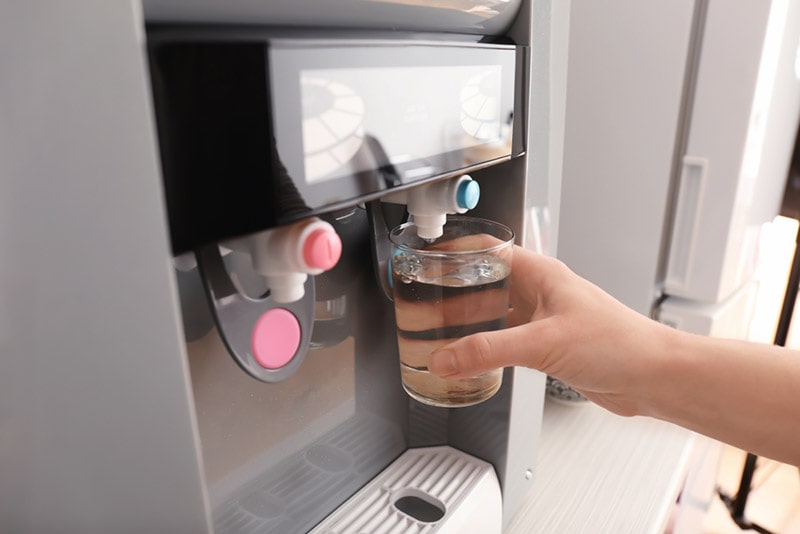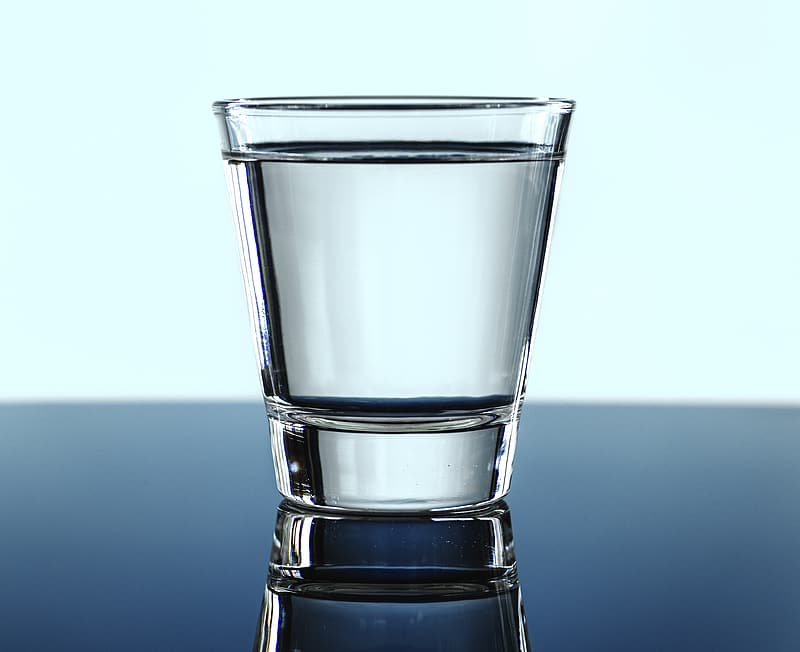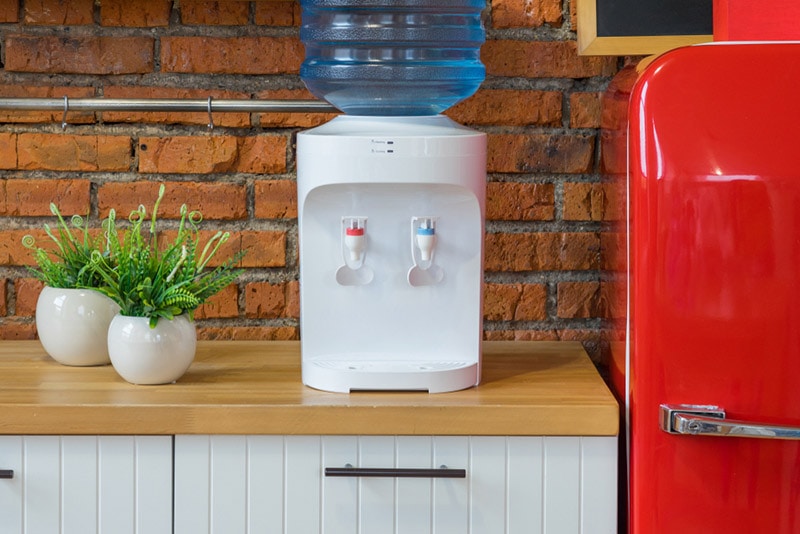How Does a Water Cooler Work? Components, Parts & Best Uses Explained
-

- Last updated:

Sipping a glass of cold water from a water cooler on a summer afternoon is a refreshing feeling. You probably know that water can be artificially cooled without a refrigerator using a water cooler, but have you ever paused to understand where the cold water comes from, and how it’s so deliciously cold?
Well, the answer is complex, but put simply, water coolers reduce water’s temperature to the desired value by using refrigerant. In this article, we will find out in detail how a water cooler works.
Water Cooler Essential Components
A water cooler is a device that lowers the temperature of water to a certain range. It ensures homeowners, students, or employees have cold water when needed.
Before understanding how a water cooler works, let us review some of its core parts.

Compressor
Water coolers and refrigerators have compressors, a device that recirculates the refrigerant throughout the cooler. A refrigerant is a special fluid mixture that transforms into a gaseous state and back to liquid to absorb heat from one region and release it to another.
A compressor is the heart of a cooler; without it, the refrigerant will stagnate at the bottommost part of the cooler.
Condenser
A condenser has coiled tubes that cool down the refrigerant and change its physical state from gaseous to liquid. In doing so, the heat is removed from the cooler and dissipated into the environment.
If you look carefully at the back of the refrigerator, you will see a dusty condenser coil, and blowing air over it is a fan. A rotating fan ensures the refrigerant in the coils cools down much faster by constantly blowing away warmed air.
Evaporator
An evaporator is a series of tubes around the water tank. The tubes bring a cold refrigerant as close as possible to the water tank to absorb heat through conduction and radiation. As heat from the liquid is transferred into the condenser, the refrigerant turns from liquid to gas.
The effectiveness of an evaporator depends on the number of coils around the water tank and the type of material they are made of. A water tank surrounded by many coils cools water faster. Similarly, coils made from an excellent heat conductor like copper will facilitate heat exchange much faster.
In modern evaporators, there is a fan that blows air around it. The process constantly removes warm air, accelerating the cooling process.

Capillary tube
Between the evaporator and the condenser, there is a capillary tube. It is a narrow, metallic tube that boosts the pressure of the refrigerant as it flows from the condenser.
Also, the capillary tube will equalize the refrigerant’s pressure during an off-cycle. This means that less torque will be required to push the refrigerant through the system after switching on the water cooler.
While capillary tubes work without any power source, they cannot adjust themselves to accelerate or decelerate the cooling process. Plus, they are susceptible to clogging.
Thermostat
The thermostat is like a water cooler’s nervous system, which is true because it responds to “environmental stimuli.” A thermostat has a bimetal which, when the temperature rises or falls, resists the current flow to a certain degree. A microcontroller then translates the resistance into actual temperature values.
If the temperature readings exceed a set value, the thermostat automatically switches on the compressor to cool down the water. Likewise, a thermostat will switch off the cooler if the temperature drops past a certain threshold.
Motor
A typical water cooler has two or three motors. The most powerful motor is part of the compressor, generating the pressure the system requires to run. The other two motors are for the evaporator and condenser fans.
With a clear picture of some of the most crucial parts of a water cooler, how does it work?

How Does It Work?
When you pour water into the cooler’s tank, it is usually at room temperature or higher. The thermostat will detect temperature differences and switch on the compressor. Pressure from the compressor will start pushing the refrigerant through the system.
There are many types of refrigerants, such as R22. R22 is a hydrochlorofluorocarbon (HCFC) commonly used in domestic coolers.
When R22 is compressed, the compressor does that by reducing its volume, which subsequently raises its pressure. Since the molecules are moving faster in the confined space, the refrigerant’s temperature rises. Pumping the warm refrigerant into the evaporator will be a terrible mistake. Instead of cooling water, it will warm it up.
To cool the refrigerant down, the now gaseous R22 is passed through a condenser. The fan blowing air over the condenser extracts heat, resulting in a change in the physical state of the refrigerant.
The liquid refrigerant then enters a capillary tube at high pressure, and when squirted into the evaporator, the pressure drops significantly. As it travels from a high-pressure region (narrow capillary tubes) and enters a low-pressure zone (wide evaporator tubes), the process further cools down R22. This is because when you reduce fluid pressure by increasing volume, the rate at which molecules bump into each other reduces, and so does the heat energy.
The now super-cold refrigerant enters an evaporator. The evaporator, which is also a series of coiled metallic tubes, directs the refrigerant around the water tank. Manufacturers use coils to maximize the contact surface, so the more coils, the faster the refrigerant cools down the water.
During cooling, the heat exchange process follows a fundamental law of thermodynamics. The second law of thermodynamics can be roughly defined as heat flowing from a region with a high temperature to a region with a lower temperature. Since the water tank has warm water (a high-temperature region), heat will flow to a cooler refrigerant (a low-temperature region). The refrigerant will heat up and turn into a gaseous state. The gas is then forced into a compressor to initiate another cycle.
The cycle of supplying the evaporator with a cold refrigerant and removing the gases repeats itself until the thermostat stops the process.
What Are the Different Types of Water Coolers?
1. Traditional Water Coolers

Before the introduction of modern electric water coolers, people had their own ways of getting cold liquid. One of them was using traditional water coolers. These coolers were large clay pots with small mouths.
After pouring water into the pot, minute pores between clay particles absorbed it. This made the pot damp. On a hot day, the moisture on the outer surface of the pot would evaporate faster, taking with it some heat. If the process continued for some hours, the water would cool down.
Communities that did not have earthen pots mimicked the same conditions by covering a plastic container with a damp blanket. As the water on the blanket evaporates, the temperature inside the container drops.
Unfortunately, the pots were less effective on a cold or warm, humid day. They required hot and dry air to cool the water faster.
2. Countertop Water Coolers

These are small water coolers for offices and homes. They are designed like water dispensers, with their main advantage being that warm water can be cooled down before being released.
3. Closed Loop Evaporative Cooling System

The closed-loop cooling system is applicable on a large scale, especially when chilled water is needed for construction projects. To work, water is first pumped into a tower. It is then released over the coils with coolant. The coils not only slow down the water but also remove heat. The water then flows into a basin. The process repeats itself until the water attains the required temperature.
Where Are Water Coolers Used?
Water coolers have numerous applications both at home and on an industrial level.
To Chill Water Used in the Preparation of Mortar
When you mix cement with water, it produces heat. Of course, heat will accelerate the setting process but may result in cracks. Engineers use coolers to chill water before mixing it with cement.
Cooling Water in Nuclear Plants
Nuclear power plants need a lot of water to cool down the reactors. Using water at room temperature will not be as effective as chilling it to a few degrees.
Cooling Down Engines
Internal combustion engines have radiators to cool the hot water coming from the engine. A radiator is a simplified version of a water cooler. Instead of using a refrigerant, radiators use cold air from the fan.
Cooling Servers and Computers
Servers and CPUs produce a lot of heat, which is a major problem. Manufacturers like Lenovo have incorporated water coolers into their servers. According to Tech Target, water absorbs heat 30 times faster than air, and in Lenovo Neptune servers, water coolers control temperature.

Advantages of Water Coolers
- The system is easy to set up
- Relatively inexpensive
- Energy efficient
Disadvantages of Water Coolers
- Most water coolers require a constant power supply
- Large water coolers are expensive
- Refrigerants used in the cooling process have HCFCs, which are not great for the environment.
In Conclusion
Water coolers reduce the water’s temperature to a required value by using refrigerant. A refrigerant is a special fluid that is pumped around the cooler’s tank to absorb heat and dissipate it. Depending on the type, water coolers are even used to cool water heading to and from nuclear reactors, control server temperatures, and in internal combustion engines.
You might also be interested in:
- 9 DIY Deck Bench Plans You Can Build Today
- 9 DIY Reloading Bench Plans You Can Build Today (With Pictures)
Featured Image Credit: Africa Studio, Shutterstock
Contents

